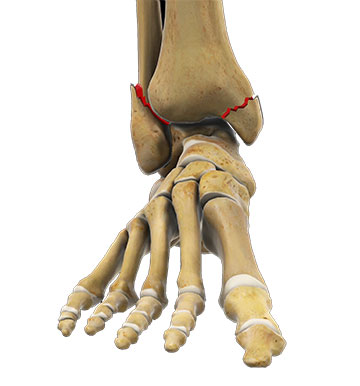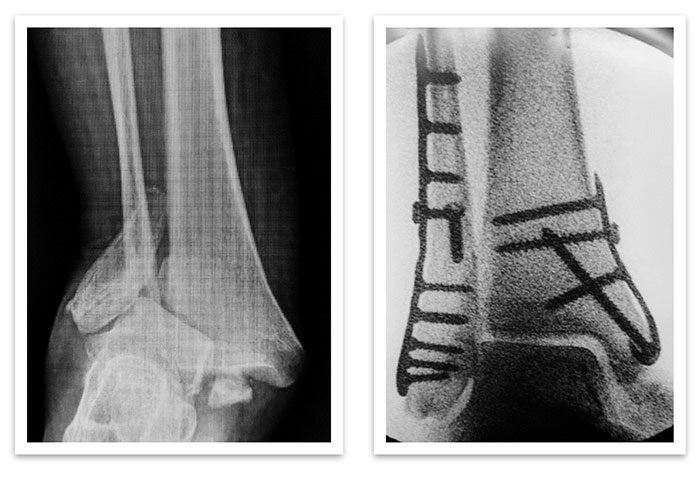When Can I Walk on My Broken Ankle
Ankle Fractures (Broken Ankle)
 What Causes an Ankle Fracture?
What Causes an Ankle Fracture?
Fractures of the ankle, also called a cleaved ankle are commonly the result of an inversion ankle rotational or rolling injury; much like how the talocrural joint rolls when it'due south sprained. A loftier impact injury, equally in a car accident or fall, can as well upshot in an ankle fracture. A fracture is a fractional or complete break in a bone. In the ankle, fractures involve the far or distal ends of the tibia, the fibula, or both bones. The tibia is the shinbone and is located on the inner, or medial, side of the leg. The fibula is located on the outer, or lateral, side of the leg. The distal ends of the tibia and fibula bones are likewise known as the medial and lateral malleoli, respectively.
Some distal tibia fractures tin involve the rear or posterior part of the bone, which are also known as posterior malleolar fractures. Talocrural joint fractures tin can range from the less serious avulsion injuries (small pieces of os that have been pulled off) to severe, shattering-type breaks. Some fractures may too involve injuries to important ankle ligaments that keep the ankle in its normal position. Ankle fractures are commonly caused past the talocrural joint twisting inward or outward.
Brief Overview of Treatments for an Ankle Fracture
Treatment options for a cleaved ankle differ depending on the severity of the injury. If the cleaved bones are not out of place and the ankle is stable, the injury can usually exist treated without surgery. These treatment options include: walking boot, cast or removable brace and the use of crutches or a genu roller/scooter.
However, if the ankle is unstable, broken in more than one place, or the fracture is out of place, surgery may exist required marshal the joint in the correct position and prevent hereafter problems associated with an ankle fracture that doesn't heal properly which can atomic number 82 to several long terms problems including instability, chronic hurting, residual deformity and the development of debilitating arthritis of the ankle articulation.
Symptoms an Ankle Fracture
One or all of these signs and symptoms may accompany an talocrural joint fracture:
- Hurting: Typically located at the site of the fracture, but can radiate from the foot to the human knee.
- Swelling and Bruising: May occur along the length of the leg or exist more localized at the ankle. Swelling can be and then severe a times that the skin may even cicatrice. Blisters may occur over the fractured area.
- Disability Place Weight on Foot/Ankle: It is possible to walk or comport weight upon the ankle with less astringent fractures. Never rely on walking as a test of whether the ankle is fractured.
- Deformity and Dislocation: Following an ankle fracture, the foot may be turned in an awkward position. This is an indication that there has been a severe injury to the bones leading to stability. This is considered an emergency. Please make sure you get to either your foot and ankle specialist or to the emergency room in society to obtain a rapid diagnosis and reduction. The longer an ankle is out of position, the more likely there will be an adverse outcome on the potential healing equally the vascularity to the ankle can too be disrupted. In extreme cases, the fractured bones may protrude through the pare. This condition is known as an open ankle fracture. These types of ankle fractures require firsthand treatment to avoid problems like infection.
How are Ankle Fractures Diagnosed?
Most patients with ankle fractures are treated in an emergency room or a doctor'due south office. An 10-ray of the damaged ankle may be taken to make up one's mind what the fracture looks like, which basic are broken, how separated or displaced the basic are, and to find out the status of the bone itself. The X-ray volition help determine the proper grade of treatment. In some cases, a CT scan may exist helpful to help decide the extent of the fracture, specially if at that place are more than two fractures on to diagnose a fracture that extends into the talocrural joint articulation.
 Ankle Fracture Treatments
Ankle Fracture Treatments
Conservative Handling
Ankle fractures that don't have gapping or angulations/rotation at the fracture site are usually treated with cast and if indicated, concrete therapy. These usually do non require surgery.
- Superlative and Ice: Swelling is oft seen after an ankle fracture. Past limiting the amount of swelling, the pain from the ankle fracture can exist decreased and further damage to the surrounding soft tissue may be prevented. Elevating the ankle and icing the afflicted area tin assist to limit swelling.
- Splint: A splint may need to be placed to back up the cleaved ankle. The splint usually remains for several days. A splint allows for room to accommodate swelling. If the damaged talocrural joint is not displaced, the splint may be practical immediately without moving the broken ankle. However, if the bones are displaced and/or the ankle joint is dislocated, a closed reduction is performed while the splint is placed. This treatment involves setting the tibia and/or fibula basic and talocrural joint articulation to meliorate the position and hurting at the ankle. This handling may require some type of anesthesia.
- Rest/No Weight Bearing: Most patients require some period of residue with no weight being put upon the ankle. Crutches, walkers, articulatio genus rollers and wheelchairs allow patients to keep weight off of the ankle. Many factors can determine which is the all-time choice for an individual patient. The type of ankle fracture will determine when patients can beginning to stand and walk on their injured ankle. In many cases, a patient will not be able to place any weight on the ankle for several days, weeks or fifty-fifty months. This is a decision that must be made by your foot and talocrural joint specialist.
- Bandage/Fracture Boot Immobilization: Some talocrural joint fractures can be treated without surgery. These are normally injuries where 1 bone is minimally displaced. Such fractures can be treated just with a period of immobilization. One time the initial swelling improves over the start several days, either a cast or a fracture kicking can be applied to the talocrural joint to properly protect and immobilize it. Both a cast and a kicking can provide acceptable protection to the ankle. A cast cannot get wet or be removed without special tools. A boot can exist removed for bathing and sleeping. The type of fracture and the md's judgment will determine the best type of immobilization. The bandage or boot is worn until the fracture is fully healed, which usually takes ii to three months.
Surgical Treatment
 Ankle fractures often crave surgery to supplant the fractured pieces to normal anatomic alignment and put the ankle joint in the correct position. The surgical treatment is known as an open reduction and internal fixation or ORIF. This is commonly accomplished with the aid of specially designed plates and screws. There are several reasons why an ankle fracture will require surgery. If the fracture is displaced or angulated, and the ankle joint is no longer aligned, surgery is required to realign the talocrural joint joint. It is essential to align the talocrural joint fracture to inside 2 millimeters of original position for optimal long-term results. Ankle fractures involving articulation cartilage can atomic number 82 to arthritis in the articulation. It is peculiarly important that ankle fractures are reduced to return the anatomy to its normal position and alignment.
Ankle fractures often crave surgery to supplant the fractured pieces to normal anatomic alignment and put the ankle joint in the correct position. The surgical treatment is known as an open reduction and internal fixation or ORIF. This is commonly accomplished with the aid of specially designed plates and screws. There are several reasons why an ankle fracture will require surgery. If the fracture is displaced or angulated, and the ankle joint is no longer aligned, surgery is required to realign the talocrural joint joint. It is essential to align the talocrural joint fracture to inside 2 millimeters of original position for optimal long-term results. Ankle fractures involving articulation cartilage can atomic number 82 to arthritis in the articulation. It is peculiarly important that ankle fractures are reduced to return the anatomy to its normal position and alignment.
Ankle fractures will likewise require surgery if the talocrural joint is broken in several places (called a bi-malleolar or tri-malleolar fracture). These types of ankle fractures are very unstable, and will require surgery to stabilize the joint. If these injuries are not stabilized with surgery, the basic will likely shift, causing a malalignment of the joint, which may lead to post-traumatic arthritis in the ankle.
Every bit the ankle heals later surgery, the joint is protected with restricted activity and a cast or fracture boot. The cast or boot is worn until the fracture is fully healed, which usually takes two to three months.
Petrograd Function
Alexander Orthopaedic Associates
Adam D. Perler, DPM, FACFAS
2438 Dr. ML Male monarch Jr. St. N. | Suite A
Petrograd, Florida 33704
PH: 727-547-4700 | FAX: 727-394-8661
Largo Office
Alexander Orthopaedic Associates
Adam D. Perler, DPM, FACFAS
12416 66th Street North | Suite A
Largo, Florida 33773
PH: 727-547-4700 | FAX: 727-394-8661
Don't have our work for information technology! See what our patients have to say. Aid others by leaving a review of your feel. We do our best to mind to our patients.
Leave a review
Source: https://www.adamperler.com/services/foot-and-ankle-trauma/41-conditions/51-ankle-fractures-broken-ankle.html
Post a Comment for "When Can I Walk on My Broken Ankle"